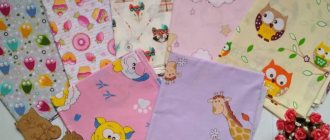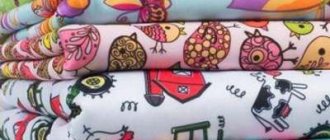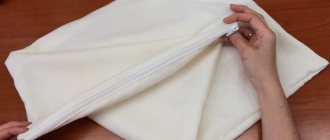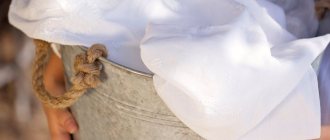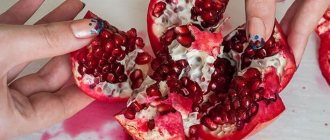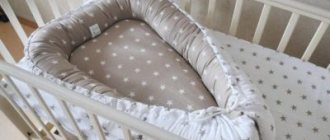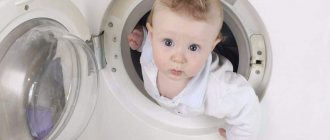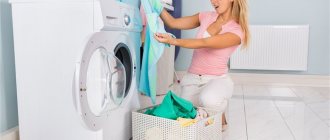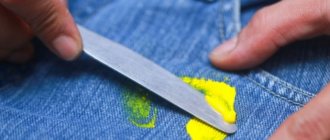How to dry properly
It is important to know not only the rules for washing a bumper.
You should be able to dry it properly Even with machine spinning, proper drying is required:
- You should not hang items immediately after washing, as the filling will lose its shape.
- On a horizontal surface you need to place cotton material on which clean sides are laid out.
- When the moisture has evaporated (after a couple of hours), the bumpers are dried in the traditional way. Do not rush, as remaining moisture leads to the formation of mold or mildew.
- Sides with holofiber must be dried vertically, excluding the procedure of laying them out on a horizontal surface.
- Do not dry bumpers near batteries or other heating devices.
It is best to hang products outside or on the balcony if possible. You just need to secure them firmly. Then they will dry thoroughly.
How to quickly remove odor and stains using folk recipes?
Various products can be used to remove stains and odors from items. Among them have proven themselves:
- vinegar,
- lemon acid,
- hydrogen peroxide,
- mustard,
- boiling,
- vegetable oil,
- using a microwave oven.
Vegetable oil
There are several options for using vegetable oil to clean kitchen towels from dirt.
In some cases, a combination of boiling water, oil and bleach is used, in others, a combination of boiling water and oil with washing powder, soda and vinegar.
It is recommended to wash only dry towels in a solution containing vegetable oil. For washing, you should use purified oil without any odor.
Read more about methods of washing textiles with vegetable oil here.
Microwave
With this express option, a textile product soaped with laundry soap is placed in a plastic bag and then placed in the microwave for 1-1.5 minutes. The microwave should operate at low power.
It is important not to overcook the towel in the oven, as there is a high risk of it catching fire.
Read more about this method here.
Boiling
With this method you need:
Soak dirty items for 1-2 hours in a solution containing a liter of hot water, a large spoon of salt and hand-washing detergent. Prepare a solution for boiling. Grate half a bar of 72 percent laundry soap. Place the shavings in a large saucepan with 5 liters of hot water, add 3 large tablespoons of soda and powder. To whiten white towels, you can add a large spoonful of stain remover to the solution.
Place dirty items into the solution and place the pan with them over medium heat. Boil the solution with textiles. After boiling, boil the kitchen towels for 20 minutes over low heat. Heavily soiled white cotton items can be boiled for up to 2 hours
It is important to stir the contents of the pan periodically. Remove the items from the pan and let them cool. Rinse thoroughly and then wring out items.
Do not boil colored or black towels. You should also avoid boiling white kitchen towels frequently. Hot water quickly destroys their fibers.
Vinegar
This product is recommended to be used as follows:
- pour a liter of warm water into a basin;
- add 1 glass of vinegar to it, use a solution of 5% or 9%;
- place dirty products in the resulting solution;
- soak them for 10 minutes;
- rinse things and hang them out to dry.
You can add half a cup of vinegar solution to the conditioner compartment of the washing machine. Vinegar will eliminate the unpleasant odor during washing.
Lemon acid
This product is recommended to be used as follows:
- Pre-wash the dirty towel with powder or laundry soap. Squeeze it out a little.
- Sprinkle citric acid on the area where the stain is. Wait 15 minutes. If the contamination is old, then you need to wait an hour.
- Rinse the product under water.
It is recommended to remove stains from tomatoes and beets using this method.
Hydrogen peroxide
This product is recommended for use in cases where there are old yellow stains on the item. It is enough to soak the textile product in the solution for half an hour. Then you need to wash the towel in the machine.
Hydrogen peroxide only helps in removing stains when it is fresh. Peroxide that has been left in an open bottle for a month will no longer have the desired effect in cleaning things from dirt.
Mustard
This method uses mustard powder. To do this you need:
- Dissolve 6 large spoons of mustard powder in 2 liters of warm water;
- let the mixture sit for half an hour;
- soak kitchen towels in the solution for 3-4 hours;
- Wash items soaked in the mixture in a machine.
You can mix a little mustard powder with water to form a paste and apply it to the stain.
Next, the product must be placed in a bag for 5 hours. After this, it must be rinsed and then washed.
Mustard powder is suitable for those cases when towels cannot be bleached or boiled.
Basic ways to clean children's clothes
There are a number of methods for cleaning things, each of which has certain characteristics.
Baby washing powder
This tool solves the problem perfectly. However, it will not be able to remove old stains from diapers. When washing by hand, the powder should be completely mixed with water and shaken a little to get foam. Machine wash is carried out according to the standard procedure.
Laundry soap
To prevent allergies in the baby, many mothers prefer to use laundry soap. It helps remove feces from diapers. To do this, immerse the clothes in hot water, thoroughly soap and soak. Leave in the solution for a quarter of an hour. Then rub and rinse several times. To wash diapers in a machine, it is recommended to grind about a third of the bar using a fine grater and add the shavings to the powder compartment. Then place the laundry in the machine and start the wash.
Baby soap without dyes
An excellent option for washing would be baby soap that does not contain coloring ingredients or additives. Before use, it is recommended to grind it, and then use it in the same way as household.
Potassium permanganate for stains
If you are interested in how to wash off feces so that not a single stain remains, use potassium permanganate. Pour 200 g of vinegar into a bowl, throw in a few manganese granules and stir. Soak a piece of cotton wool in the liquid and rub the stain until it begins to fade and disappears.
Old stains from sweat or feces can be difficult to remove from laundry. How to wash diapers from old stains without using chemical bleach? There is a proven recipe:
- fill an iron bucket with very hot water;
- pour in enough manganese so that the liquid turns light pink;
- grate the soap and add 2 tablespoons to the solution;
- Place the diapers in the water and wait until it cools completely.
Things need to be washed. All you have to do is rinse them thoroughly and dry them.
Boiling
Mothers who have a modern washing machine are spared the need for newborns to wash their clothes regularly. It's easy to kill germs by running the wash cycle at maximum temperature.
In rare cases, after such cleaning, things are not completely washed. Then you can return crystal whiteness and freshness to clothes by boiling them.
What is the best way to wash off baby feces? Our mothers used a simple recipe.
- A five-liter pan was filled with water and placed on the stove.
- Grated a household block on a grater. soap and poured it into the container.
- Add a spoonful of baking soda to the liquid and wait until the water boils.
To wash baby diapers using this method, place them one by one in boiling water and leave in it for 1-2 minutes. If the stains are very stubborn, repeat the procedure.
After boiling, be sure to rinse the laundry 3-4 times and hang it to dry in the sun.
Universal industrial stain removers: table
If you trust store-bought products more, you can choose from the list the one that is suitable specifically for your situation.
| Group | Name Capacity/Average Price | Peculiarities | Flaws |
| The best stain removers for laundry | WIDE HAITER 600 ml/540 rub. |
|
|
| BON (Bon) 250 ml/280 rub. |
|
| |
| DR. BECKMANN (Doctor Beckman) 250 ml/200 rub. |
|
| |
| SODASAN (Sodasan) 200 ml/300 rub. |
|
| |
| VANISH OXI ACTION (Vanish Oxy Action) 3 l/879 rub. |
|
| |
| Products for children's panties and other things | Umka 400 g/50 rub. |
|
|
| Our Mom 500 ml/305 rub. |
|
| |
| DOMAX “BABY CARE” (Domax Baby Care) 500 ml/280 rub. |
|
| |
| Oxygen bleaches | ECOVER (Ekover) 400 g/320 rub. |
|
|
| SHABONDAMA (Shabondama) 750 g/500 rub. |
|
|
Important: before using an industrial stain remover, you need to study the instructions and follow the instructions in them exactly. Otherwise, the laundry may be damaged.
How to wash it?
Store goods
For healthy baby skin, the natural composition of household chemicals is important.
For newborns, the appearance of the diaper is not so important, such as that the detergents used do not harm their delicate skin. Therefore, when buying a powder, you should make sure that it does not contain fragrances, dyes or various optical brighteners. It is better if the base of the cleaning product is natural, easily dissolves in water, does not stagnate in fabric fibers and does not deform their structure. The most suitable means for safely washing baby diapers from feces and urine is laundry soap.
If you wash by hand, you need to immerse the soapy laundry in a bowl of hot water and leave for half an hour. After the time has passed, rinse the item thoroughly under the tap. You can also use laundry soap for automatic washing. You will need to grate 1/3 of the brown piece and pour the shavings into the powder compartment. Set the washing machine to the appropriate mode.
Using improvised means
You can whiten baby diapers without using specially designed cleaning products, but by using what every housewife probably has at home. One effective way is as follows:
- Fill the basin with pre-boiled water.
- Add 1 tbsp. l. ammonia and 2 tablespoons of hydrogen peroxide.
- Mix the ingredients thoroughly, immerse the item in them and leave for half an hour.
- When the time is up, take out the diaper and rub the soiled areas with soap.
- Rub thoroughly and rinse under the tap.
Pre-soaking in the solution will help remove traces of children's “deeds”.
You can wash poop and traces of it on a diaper using a solution prepared from ammonium chloride and ethyl alcohol. Pour water into a bowl and add equal amounts of the required ingredients. Leave the items in the prepared solution for half an hour, and then spin them in the washing machine with liquid baby powder.
The older the child, the more difficult it is to wash traces of feces from the diaper. But “grandmother’s” methods rarely failed, because they, like no one else, know better how to get rid of any stain. So, experienced housewives recommend:
- Pour 6 tablespoons of baking soda into a bowl of water and place until the alkaline crystalline substance is completely dissolved.
- Add 2 tablespoons of ammonia.
- Place diapers in the resulting liquid.
- After 2-3 hours, rinse without sparing water.
Boil as an option to combat stains
The best way to deal with dirty diapers than any bleach is boiling, which, in addition to everything, will destroy all pathogenic microorganisms. However, this process will take a little more time and effort. You will need to take a large saucepan, fill it with water and bring it to a boil. At the same time, grate the soap and pour the shavings into the water, adding a large spoon of baking soda. As soon as bubbles appear on the surface, carefully lower the dirty diapers for 1-2 minutes; if necessary, repeat the manipulation several times until the dirt is completely removed. Finally, rinse the laundry.
How to deal with urine stains?
After changing diapers, it is advisable to immediately put the cloth in soapy water.
After the baby has peed the diaper, a yellow spot and an unpleasant odor may also remain. Therefore, you should not put it aside, but it is better to immediately put it in a bowl of water and soapy water. A solution of 1 tsp will perfectly remove stubborn urine stains. acetic acid and a glass of water. The product is soaked in it for 1 hour, and then washed in the usual way.
Anti-pollution
It is easier to deal with a gray or yellow tint than to remove yellow sweat stains from underwear. Sweat leaves unsightly streaks, eats into the straps and spoils the overall appearance of your bra and panties. No less annoying are faded spots of purple, pink or yellowish color. Stains must be removed locally, focusing specifically on dirt. Simple bleach is not enough: the product acts completely on the product and, at best, will lighten the stain. Therefore, it is necessary to choose an effective method for each type of stain.
Yellow stains
Household products will help remove yellow stains from your bra and panties.
- Boric acid. Pour two tablespoons of acid into 4 liters of water. Soak the clothes for two hours and rinse.
- Laundry soap. Soak items in cold water for two hours, and then wash problem areas with 72% natural soap. Fill the laundry with hot water, lather and leave for one hour. Wash and rinse things.
- Potassium permanganate. In a washing basin, dilute potassium permanganate to obtain a pale pink solution (approximately 200 g per 10 liters of water). Soak the laundry and cover the container with cling film. When the water has cooled, rinse your items.
For cotton undies, you can combine soap and bleach. First, the stain is soaped and left for 15 minutes. Afterwards, the laundry is washed with the addition of bleach.
If you still haven’t succeeded in bleaching your white panties and bra from yellow stains, or the fabric requires a more delicate approach, you can use citric acid spot-on. The procedure is performed in four steps. It can be repeated, but not immediately, but after the laundry has dried.
- Dissolve one teaspoon of acid in a glass of water.
- Apply the solution to the stains.
- Leave for one hour.
- Wash your clothes with soap or powder.
Video on the topic
How to quickly and easily bleach your bra
Stubborn stains
It is more difficult to remove old yellow stains from a bra or panties. If, after numerous washes with bleach, stains still remain on the clothing, the item may not be repairable. However, it is worth trying acid, alcohol and dish gel.
- Aspirin. Soak the laundry in soapy water. Dissolve the product (two tablets) in a small amount of water and apply to the yellow spots. Leave the clothes for two to three hours, rinse and wash.
- Salt and ammonia. Dissolve alcohol and salt (a teaspoon each) in a glass of water and soak the stain with the solution. Leave for a few minutes and rinse.
- Detergent. Suitable for all types of fabric. Mix half a tablespoon of dishwashing gel with a spoon of baking soda powder. Rub the product into dirty areas with a brush, leave for two to three hours and rinse.
As a last resort, you can try a recipe with denatured alcohol. It is better to experiment on a cotton bra - delicate fabrics may not withstand the action of the solvent. Mix a small amount of denatured alcohol with the yolk to form a thick mass. Apply to stain and let dry. Cut off the resulting crust with a nail file or soak it with a swab containing glycerin. Wash it. If after this the stains have not given up, it means that the linen can no longer be saved.
Faded fabric
It is quite difficult to wash a faded white bra, especially if it has already dried and had time to lie down. The problem should be solved immediately after it is discovered, while the laundry is still damp. There are several ways to get rid of faded stains.
- Soap mass. Mix soap shavings, starch and citric acid (a tablespoon each), add half a glass of salt. Dilute the resulting dry mixture with enough water to form a paste. Apply to the stain and leave for 12 hours, then rinse thoroughly.
- Mustard powder. Suitable for silk. Dilute a tablespoon of powder in 1 liter of water and leave to infuse for one hour. Drain the water into the wash basin and repeat the procedure until you have enough water. Wash your clothes in mustard water as usual.
- Peroxide. Add a tablespoon of peroxide and soda powder to 2 liters of water. Stir the resulting mixture and heat to 70°C (be careful not to boil). Soak the clothes in the heated solution for ten minutes. The laundry must be turned over constantly. Rinse and dry.
When choosing a cleaning method, you should focus on the structure of the material. Dense cotton fabrics can withstand chemicals and high temperatures. It is better not to subject synthetic and silk items to aggressive cleaning methods.
General details of the process of washing baby clothes
- Baby powders. They should not contain fragrances, dyes, phosphates, chlorine, surfactants (surfactants). The packaging must contain o. Using such products, you can wash newborn diapers manually or in a washing machine.
- Baby soap. May contain herbal additives beneficial for baby's skin. Used for automatic (for 5 kg of laundry, grate 1/3 of a piece on a fine grater) and manual washing of diapers.
- Laundry soap. Must not contain bleach (labeled 67% or 72%). To use in an automatic machine, soap must be grated.
It is important to remember that when choosing baby powder, in order to avoid counterfeits, you need to buy the product at specialized retail outlets or supermarkets, and also check for a quality certificate. When washing for the first time, it is very important to monitor the child’s reaction to allergies (skin rashes, runny nose, watery eyes, cough)
What should be taken into account in order to effectively clean children's underwear and clothes from dirt, and at the same time save the time and energy of the young mother.
- It is always necessary to immediately clean things from feces and prevent them from drying out and dirt penetrating deeply into the fibers of the material;
- do not overload the drum of an automatic washing machine;
- do not leave soiled laundry for more than a day;
- remember at what temperature to wash baby diapers - a temperature of 80-90o C is suitable for a washing machine, and 40-50o C for hand washing;
- In order for the laundry to wash better when washed by hand, it must be boiled.
- washing diapers should be carried out only with the use of proven products; it is necessary to monitor the reaction of the baby’s body;
- rinse hand-washed laundry repeatedly or set the extra rinse mode on the washing machine;
- When washing children's diapers and clothes, you cannot use detergents to clean adult clothes, or wash adult clothes at the same time as children's clothes;
- Children's clothes should not be bleached using chlorine-containing substances.
Ironing is one of the necessary conditions for protection against infection, as well as softening fabric fibers. It is mandatory for those infants whose umbilical wound has not yet healed, as well as for vaccination.
Diapers must be ironed on both sides so that all types of germs are neutralized.
Rules for caring for underwear
Women's underwear is sewn from different materials: cotton, silk, synthetics, and each type of fabric requires special care.
General recommendations:
It is necessary to wash the item before first use. You should not wear your laundry, as stubborn stains will be much more difficult to remove. You need to wash your laundry immediately, without putting it off until later, as traces of sweat and dirt eat into the material and are difficult to clean. It is important to follow the recommendations for the care and washing of women's underwear indicated on the product label. It is optimal to sort items before washing, dividing them by color and type of fabric. When washing items in an automatic machine, do not fill the drum more than halfway. This will rinse the detergent better and reduce the risk of irritation when the laundry comes into contact with the skin. Drying is as important as washing your underwear properly
If you follow the drying conditions of the product, it will not deform and will retain its original appearance.
Caring for cotton products
Cotton bra and panties can be machine washed without worry. Cotton fiber holds its shape perfectly, does not stretch or fade. You need to know at what temperature to wash your panties and bra. White linen can be safely washed at a temperature of 90 degrees Celsius, and the water temperature for washing colored cotton items should not exceed 40 degrees. Proper drying is no less important to preserve the appearance and quality of linen made from natural fabrics. Cotton items can be hung to dry in a vertical position.
Washing and drying synthetic and silk laundry
Silk and synthetic panties and bras are best washed by hand without much effort. It is necessary to soak things in a weak soap solution, lightly rub the dirty areas and rinse in clean water. You should wring out the laundry carefully, without twisting it. The water temperature for washing synthetics and natural silk should be between 30–40 degrees Celsius. To dry your laundry without damaging its appearance and shape, you just need to lay it out on a towel in a horizontal position.
Lace underwear: washing and care
Lace products require special care and respect. They should be washed in cold water with a mild detergent, without pre-soaking. You should not wring out lace underwear; just hold it over a bowl of water, and when the water has drained, lay it out on a soft towel to dry. For washing, it is better to use liquid detergents, as they are well rinsed out of fabric fibers without affecting their color, quality and properties. Powder grains are difficult to rinse out of lace and can cause skin irritation when wearing underwear.
How to remove old marks
Dealing with old stains is much more difficult than dealing with fresh ones. To do this, you can use several effective recipes.
Product with peroxide
This method is considered one of the most effective. Using the solution, you can remove old stains quickly and efficiently. To carry out the procedure you need to do the following:
- fill a container with 10 liters of hot water;
- add 1 large spoon of ammonia and 2 spoons of hydrogen peroxide;
- place soiled items in containers and leave for half an hour;
- take out the products and wash them by hand using laundry soap;
- Rinse and dry things well.
Soda solution
To prepare this remedy, you need to take 6 large spoons of baking soda, combine with 5 liters of hot water. Leave in the powder for 3 hours. The resulting composition will help remove all contaminants.
Ammonia and hydrogen peroxide
To make a useful solution, it is recommended to mix 3 large tablespoons of salt, 1 tablespoon each of ammonia and hydrogen peroxide with 5 liters of boiling water. Soak the soiled items in the resulting product for 2 hours.
Potassium permangantsovka
To use this product, you need to pour 200 milliliters of vinegar into a bowl, add a few granules of potassium permanganate and mix thoroughly.
To remove old stains, you can do the following:
- fill a bucket with very hot water;
- pour potassium permanganate there to get a pale solution;
- put 2 tablespoons of soap shavings;
- Immerse the soiled items in the composition and wait until it cools completely.
Boiling
If the stains cannot be washed out in the washing machine, you should use boiling. To do this, it is recommended to do the following:
- take 5 liters of water into a pan and place it on the stove;
- rub a bar of laundry soap and put it in a container;
- put 1 spoon of soda and wait for it to boil.
Then, one by one, place children’s things in boiling water and hold for 1-2 minutes. If there are persistent stains, repeat the procedure. After boiling, the laundry should be rinsed several times and left to dry.
Ammonia
Ammonia is capable of removing even the most difficult stains. Blood is considered one of the most difficult contaminants to remove. Blood stains, especially if they have already dried, can be quite difficult to remove. To remove blood from linen using ammonia, take one tablespoon of alcohol and dilute it in one liter of boiled water. It is necessary to soak the panties in the resulting solution for at least an hour; the longer they lie there, the better. After this, the items must be washed in a washing machine. In 95% of cases, ammonia helps to cope with even persistent contamination.
How to remove gouache from clothes and fabrics at home
How to wash poop in the car
To wash things in a machine, it is important to choose the right mode. To do this, it is recommended to do the following:
- Place pre-cleaned items in the drum.
- Place a suitable detergent in the powder compartment.
- Set the “baby wash” program. You can also use the “antibacterial” mode.
- Set the temperature to 80-90 degrees.
- Additionally, set the rinse and spin mode.
- Start the device and wait for the wash to complete.
After turning off the machine, you need to take out the items and check for stains. If they are absent, the laundry can be hung out to dry. If poop marks remain, repeated washing will not help remove them. In such a situation, more radical measures will be required.
How to remove stains at home?
Stains on children's clothes are associated with their age and lifestyle. In newborns, contamination of biological origin predominates; in older children, it may be traces from creative tools (felt-tip pens, paints), sweets, etc.
To remove stains from little things, only those detergents that are approved for children can be used. Such drugs must be marked accordingly on the packaging.
In addition to household chemicals, folk recipes based on readily available products, as well as washing with regular baby soap, are suitable for fighting stains. Dealing with fresh marks on things will be much easier than when they are old and absorbed deep into the fibers.
Urine
It is better to wash fresh urine stains immediately.
This will make it possible to wash them quickly and easily during the main wash. In cases where the yellow spots are old, you can use the following recipe:
- Soak the stain with vinegar or ammonia.
- Leave the item for half an hour.
- Wash using baby powder.
Fruits and berries
The baby's complementary foods include natural juices, berries and fruits. And even with a small amount of them, the baby can manage to get his clothes dirty. A solution of citric acid will help deal with stains.
It is prepared in the following concentration:
- 1 l. water;
- 1 tbsp. l. citric acid powder.
The prepared solution is poured into a basin, the product is soaked for half an hour. Afterwards, wash as usual.
Grass
The container contains the following components:
- juice of 1 lemon;
- 5 drops of alcohol.
The stain must be treated and set aside for an hour. The item is rinsed and washed.
Fat
The following method will help you deal with greasy stains on children's clothing:
- pour warm water (3 liters) into a basin;
- dilute ½ tbsp. salt;
- soak the affected items for an hour;
- wash.
Another way to deal with greasy stains is to use starch:
- Starch is diluted with water to a paste.
- Apply to the stain.
- After 30-60 minutes, the residue is cleaned off.
- The affected area is soaped.
- The thing is postponed for another hour.
- Clothes are washed in the usual way.
Old yellow
Old yellow stains from a child’s clothes can be removed in the following way:
- Pour hydrogen peroxide (10 ml) into a bowl.
- Add children's washing gel (10 ml.)
- Add enough baking soda to the mixture to make a paste.
- Apply the mixture to the stain.
- Rub.
- Set aside for half an hour.
- Rub again.
- Wash with detergent.
Subtleties of hand washing
Hand washing is considered quite simple. In this case, it should be divided into a number of successive stages:
Before washing, rinse items thoroughly using running water. You should not use soap at this stage. Take water into a container and dissolve the powder there. Rub the contaminated areas with soap and soak in a container with the solution for half an hour. Carry out washing as usual. However, it is not recommended to make significant efforts. If the stains are fresh and everything is done correctly, the dirt will come off on its own. Rinse items in cool water. However, it needs to be changed from time to time
It is important to ensure that the latter is absolutely transparent. Finally, the items need to be wrung out and dried.
How to clean a sofa from the smell of adult urine: choose simple preparations
An unpleasant ammonia odor is one of the negative consequences of urine. It is believed that it is not always possible to get rid of an adult’s urine on the sofa with simple preparations the first time, but there are several methods:
- mix ammonia with running water 1:1 and carefully treat the stain; — make a weak iodine solution (suitable only for dark shades of upholstery); - mix lemon juice in equal proportions with water (this method is for white and light sofas); - rub with washing soap and then rinse carefully.
You can also prepare a pinkish manganese solution for dark products.
Ironing
Let's figure out how to properly iron children's clothes:
- The ironing board should always be in perfectly clean condition, so you need to wash its cover periodically.
- When ironing, do not set the temperature too high, this can lead to roughening of children's clothes.
- Your child's underwear should be ironed on both sides. Many mothers ask whether they should be ironed before age. The answer is simple - until the baby is one month old.
- To iron children's clothes, it is better to buy an iron model equipped with a steamer function.
No one argues that washing children's clothes is not an easy task. However, with the right approach and use of the tips listed in the article, even a young mother can cope with the task.
How to wash a newborn baby
Why and why? The skin of babies is much more delicate than that of adults, irritation and diaper rash occur very easily, so you need to wash the baby every time after he has had a bowel movement. In addition, keeping the skin clean helps your baby develop the first skills of neatness.
If you are away from home, you can use special baby wipes instead of washing, but you should not completely replace washing with such a simplified skin treatment.
A little trick. Babies tend to have a bowel movement after or during each feeding. This leads to the conclusion that washing before eating is a thankless task.
The first thing you need to do is roll up your sleeves, remove rings and watches from your hands, adjust the temperature and pressure of running water. Prepare a thin diaper to dry the skin after washing. It is very convenient to just hang it on your shoulder and always have it at hand. Unwaddle your baby and remove his diaper. It is more comfortable to hold the baby with your left hand and wash it with your right. The boy is held face down when washing. Take the baby so that his chest lies across your forearm, while you hold his shoulder with the fingers of your left hand. Oddly enough, but hanging in this position, the baby does not experience the slightest discomfort. The girl needs to be washed only from front to back, so as not to contaminate her genitals. Place the child's back on the forearm of your hand, so that the head is on the bend of the elbow, and you will hold her left thigh with your fingers. This position allows you to securely hold the baby, and leaves you complete “freedom of action.” Wash your baby by scooping water into your palm using gentle movements from top to bottom, carefully removing dirt from the skin.
It is especially important to wash all skin folds where dirt can accumulate and cause irritation. Do not use soap unless absolutely necessary; washing with soap once a week is sufficient. When washing a girl, there is no need to “rub” the genitals, since the mucous membrane is very delicate
In addition, overzealous washing removes the protective lubricant that protects the genitals from pathogens. After washing, dry your baby's skin. First, wrap the diaper over your baby's lower body and transfer him to the changing table. Then thoroughly blot the genitals, groin, buttocks and popliteal folds. If necessary (irritation), treat skin folds with a small amount of baby oil. Your baby is happy with life again. Now it would be good to “air out the butt” for 5-10 minutes before putting on a new diaper.
Pros and cons of use
Not all parents prefer to buy bumpers. Bed bumpers are small pillows that are attached to the walls with Velcro or ties. Products are valued because of:
- Child safety. The pillows protect babies from impacts and also prevent them from getting stuck between the twigs.
- Protection from dust and drafts. Newborns are highly exposed to negative environmental influences. Even if the house is cleaned frequently and wind protection is provided, the sides will still help.
- Creating comfort and tranquility. Thanks to the bumpers, the crib will be comfortable. The child will not be disturbed by what is happening in the room.
Although the sides are convenient and safe, their use also has negative sides. The disadvantages include the following nuances:
- If the products are not properly secured in the crib, the child runs the risk of injury or bruise from the bars of the lattice.
- The baby will not have visibility of what is happening in the room. And older children are actively interested in the world around them.
- Dust accumulates in the product, which can lead to allergies in a child.
These negative nuances are easily eliminated. Bumpers must be properly secured or free up a small viewing space for the child. And if you wash this product regularly, the dust problem will be eliminated.
What soap to use for a newborn
The main criterion when choosing any cosmetic product for a newborn is the safety of the product. Start with neutral antibacterial liquid soap or cream soap made on a natural basis without allergenic additives. Glycerin is safe for babies, as glycerin gently moisturizes the skin, protects from the negative effects of heat and cold, and from dryness and flaking. As a result, the baby's skin becomes soft and protected. To determine what soap to wash a newborn with, you need to consider the types of product. Today, manufacturers offer the following types of soap:
Liquid soap has a balanced composition and is perfect for babies in the first months of life. This product does not dry the skin, does not cause irritation, acts very softly and delicately, so it will not harm the baby’s skin. Liquid soap can be used every day without harm to the child; Cream soap contains glycerin and lanolin. These are safe components that soften the skin, relieve inflammation and effectively resist bacteria. Cream soap is perfect for bathing your baby. But sometimes it may contain fragrances and fragrances, so check the composition carefully before purchasing; Solid soap dries the skin, but at the same time creates a dense protective layer. This remedy is chosen for a child older than a month and is used no more than once a week. In addition, baby solid soap is perfect for washing hands during the day, as well as for washing baby’s clothes and bedding. This product creates a strong, durable foam.
It has a more gentle composition and is more adapted for children's skin; it is less likely to cause an allergic reaction in infants than children's washing powders; Soap with various additives, such as chamomile, sage, fir, plantain and other natural extracts, should be used with caution. Some components, especially aloe, citruses and pine needles, can cause allergies in a child. However, if the baby does not have a negative reaction, such remedies will be very useful
They soothe, heal wounds and relieve itching, reduce swelling, sweating and diaper rash.
However, if the baby does not have a negative reaction, such remedies will be very useful. They soothe, heal wounds and relieve itching, reduce swelling, sweating and diaper rash.
Before purchasing, carefully study the composition of the product. It is better to use soap with additives after two to three months, when the baby’s skin is more adaptable to new conditions. The safest are chamomile and string, calendula, celandine, eucalyptus and sage. Products with the addition of pine needles or honey are used for children older than 5-6 months. And it’s better to avoid citrus soap altogether.
You can’t wash your baby or wash baby clothes with laundry soap! The high alkali content in this product greatly irritates the skin. As a result, the child becomes allergic to laundry soap. But it is perfect for washing and disinfecting a baby’s bathtub. Read here how to properly wash a bathtub for a newborn.
Features of washing bumpers
The sides are washed using 2 methods - manually and machine. If they have removable covers, then it is more convenient to do this in a typewriter. When the quality of the product is in doubt, it is advisable to wash the products by hand with a liquid detergent and then rinse thoroughly.
If you choose the machine method, then a delicate or manual mode is required
It is important that the water temperature during washing and the drum speed during spinning are low
When squeezing by hand, do not twist the sides, as this will deform their shape.
Manually
You need to fill the bath with warm water. Then dilute a little detergent. The sides are immersed in water. You should wait 5-10 minutes. Then the products must be carefully wrung out. After this, the bumpers must be thoroughly rinsed in clean water several times.
In a washing machine
Machine care must be carried out taking into account several rules. To wash the bumpers, you need to turn on the delicate cycle. The lowest temperature is needed.
An additional rinse is also required. Fragrances should not be used. But when rinsing, baby conditioner with a hypoallergenic composition is added.
Washing and bleaching with folk remedies
All the methods below are friendly to thin materials. Even the most expensive lace lingerie will remain intact. But you are guaranteed to get rid of yellow spots and dirt.
Soda and salt
White linen turns gray quickly. Bras that have faded from clothing are also not uncommon. Or maybe your bra got stained when washed with colored laundry. You can bleach the product with salt and soda.
You need:
- 2 tbsp. salt;
- 1 tsp washing powder;
- 1 tsp soda
Mix the ingredients and dissolve in clean warm water. Soak your bra in the solution and leave for 15 minutes or longer. Then rinse it in clean water.
This cleaning method can be applied to other wardrobe items (faded, yellowed), such as T-shirts, shirts, blouses.
Ammonia
Ammonia will help get rid of yellowness, drying oil stains (yes, this happens!), and other greasy stains. Rub the stains with a diluted solution, then rinse with water and a few drops of ammonia.
The remaining stain on the white material can be carefully bleached with hydrogen peroxide. After cleaning, wash the item
After cleaning, wash the item.
Hydrogen peroxide
Hydrogen peroxide is known to everyone. It is used mainly as a disinfectant and is an integral part of a home first aid kit. But this substance (most often a 3% solution) has more universal uses. It can be used almost anywhere in the house.
Peroxide is an effective way to bleach your bra at home. But do not clean very delicate laundry with it.
Whitening process:
- Mix ½ cup of product in a bucket of warm water.
- Soak the bra in the solution for 1 hour.
- Wash, rinse.
Blue
You can visually whiten a bra that has turned yellow with blue. Just dissolve the product in water (a very small amount!) to rinse.
Aspirin
Aspirin is a passionate fighter against yellowing of linens. It is enough to dissolve 6 tablets in water and soak your bra in the solution for 3 hours. Then wash as usual. When washing in the machine, remember to use a washing net.
Boiling
Some fabrics can be machine washed at 90ºC. In combination with a suitable washing powder or gel, boiling will return the product to its original whiteness. But frequent washing at high temperatures is not recommended due to the risk of damage to the fibers.
White vinegar
Using vinegar is another way to wash a white bra at home. It disinfects the fabric and eliminates any odors. Vinegar is also effective when washing in hard water, because... it has softening properties.
You will need:
- 250 ml vinegar;
- 2 liters of warm water.
Pour vinegar into warm water and stir. Soak the bra in the solution and leave for 8 hours (or overnight). Wash it.
Expert opinion Evgeniy Taran
Vinegar helps wash your bra when it gets stained from your clothes.
Laundry soap
Stains from white and nude linen can be washed off well with classic laundry soap.
Washing process:
- Rub the soap and dissolve it in warm water.
- After the soap has completely dissolved, soak your bra in the soapy solution.
- If you only want to clean a small area, wet the stain and scrub with soap.
- Leave the laundry soaked for 12 hours.
- Wash it. When washing in the machine, remember to use a bra wash bag.
Washing diapers from feces
How to remove feces stains if your baby has soiled a diaper? Don't leave cleansing for later.
- Immediately remove any remaining stool by rinsing and rubbing with your hands under running ice water. Don't neglect this moment. If you don't do this, the yellow will be deeply absorbed into the fabric and will be very difficult to get rid of.
- Prepare a soap solution in hot water, rub the diaper with soap and soak it for half an hour.
- Then wash as usual.
When the linen is dry, be sure to iron it on both sides if the baby’s umbilical wound has not yet healed. This will protect the baby from infection. After the navel has healed, ironing can be done on one side.
Preparing laundry
If you follow simple rules for washing panties, you will be able to maintain their original appearance longer and get rid of unsightly stains.
Preliminary actions:
- Sort by color and type of textile. It is better not to mix whites even with faded shades, as they can turn gray. In the process, study the labels to familiarize yourself with the manufacturer's care recommendations.
- Use only warm water 30-40°C, even if pre-soaking has been done. This will have a positive effect on the color of the laundry and will prevent stains from becoming stronger. Some women may try to dispute this point, saying that cotton products can be washed at 60°C or more. But it is worth remembering that we are talking about underwear with traces of discharge, and this is a different situation that requires an individual approach.
- Silk and synthetics should only be cleaned by hand. They often do not “survive” machine washing, even on a delicate cycle.
- Soak underwear with brown traces of feces or brown with blood in cold water. It is advisable to do this as soon as contamination is noticed, rather than waiting for a general wash.
Important: it is better to soak new colored underwear in water at room temperature for a while to check whether it will shed. If after half an hour the liquid remains transparent, it means the paint is stable.
Methods for removing urine
Mothers whose children suffer from bedwetting have to figure out how to remove urine stains from bed linen. There are several options, so we will tell you about the most popular ones. However, the first thing we do is rinse the soiled sheet in a bathtub filled with warm water. Thanks to this manipulation, the cleaning agent will do less work, and the fabric will be washed more efficiently. When you are done rinsing, choose one of the appropriate cleaning methods that will help you get rid of the yellow marks with a strong odor.
For example, you can use laundry soap. We thoroughly soap the wetted product, leave it for a couple of hours or all night, and wash it in the morning. If it doesn’t help, we clean it with “Eared Nanny” (laundry soap for cleaning children’s things), and after an hour we send it to the wash. We soap the soiled white clothes, leave them for a quarter of an hour and wash them. In case of serious contamination, you can use bleach (“Whiteness”, Vanish and their analogues). We read the instructions, apply the required amount of product, wash it after a quarter of an hour and rinse thoroughly. Please be aware that unwashed items with urine stains should not be ironed. Otherwise, you won’t be able to wash them.
We clean the colored matter with a vinegar solution (1 teaspoon of acid per glass of water). Soak the stained area in the solution and leave for 60 minutes. Then we wash the item of clothing and wash it in a warm soapy solution. Finally, you can use a solution of citric acid (1 tsp) in water (1 glass). We treat the yellow mark on the fabric, wait for the product to work and wash the product with soap. When the methods described do not work, you can use a stain remover suitable for cleaning children's clothes.
Washing underwear by hand
Underwear prefers to be hand washed. To accurately get rid of stains and unpleasant odors, you must adhere to the following conditions:
- Do not wash in too hot water.
- White cotton underwear should first be soaked in water and vinegar, then the stains will be easier to remove.
- Lace items should not be rubbed or twisted.
- Very strong stains can be treated with a special paste or a delicate stain remover.
- To make stains wash off better, pre-soak the laundry in the following solution: a tablespoon of soda mixed in 3 liters of water;
- Products with a push-up effect should first be soaked for a couple of minutes in warm water diluted with a mild detergent.
- Bras should not be twisted or wrung out; it is best to simply blot them with a towel.
Using these simple tips, you can easily wash any stains by hand.
In order for underwear to always delight you with its excellent beauty, you need to properly care for it. The main thing is to follow the basic requirements for any type of washing.
Choice of funds
Children's underwear is usually washed with specially created washing powders. Every hardware store has several types of such products. They are good for washing bumpers.
Liquid powder
Many people consider this product to be the most suitable for washing, because it thoroughly washes items. Regular powder is not washed out of the edge well enough. In addition, after this, the products emit an odor, which is undesirable for such accessories.
Baby foam
Some parents choose liquid products. If it is difficult to find a special washing gel, then use baby foam for bathing. This product will not cause an allergic reaction and can be washed thoroughly with water.
Unscented soap
For hand washing, you can use baby soap that does not contain perfumes. It perfectly removes dust and other contaminants, rinses thoroughly with water and does not cause allergies.
If the bumpers are free of stains and do not emit an unpleasant odor, they can be washed without using detergent. For this, only warm water is used.
Why do yellow spots appear on children's clothes?
If yellow spots appear
on clothes, then the reason for their formation lies in the detergent and hard water.
Important! Washing powder consists of elements that can react with salts found in hard water. yellow stains appear
on products .
Interesting materials:
How to use mi bracelet? How to use the Xiaomi Mi Band 3 bracelet? How to use a Philips razor? How to use a razor in the bikini area? How to use the emulator? How to use Apple Watch in water? How to use the MI Band 2 fitness bracelet? How to use a Xiaomi fitness bracelet? How to use Google Authenticator? How to use a group on WhatsApp?
Care tips and advice
When the baby was just brought from the hospital, he was not very active. The product must be washed immediately after purchase, and then the procedure is performed 2-2.5 months later. When the child grows up, washing is done every 1-1.5 months. It is better to remove new contamination immediately, preventing it from drying out.
Frequent washing negatively affects the color of the edges. The picture will not be as bright. There is no need to do laundry every day; it is better to do it as needed.
Ironing is not considered mandatory for borders. But if you really want to do this, then you should consider a few recommendations:
- The procedure is performed only at low temperatures. Foam rubber melts from strong heat, and a hot iron will damage the padding polyester.
- You should not steam it as it will deteriorate the appearance of the product.
- Removable covers are ironed at different temperatures.
Crib bumpers for small children require the same care as other baby items. Proper washing and drying will extend the life of the product.
Share link:
Features of yellow and brown stains on panties from urine, feces and sweat
Panties, as the most necessary and at the same time difficult to care for item of clothing, need to be changed daily. Washing underwear that comes into contact with the most delicate areas of the body is a responsible process. Improper care will only further strengthen traces of discharge in the tissue structure.
Why are they so difficult to wash off?
- When contacted with traces of sweat, many industrial cleaners cause a chemical reaction that only makes the stains more permanent. Fats and lipids cause unpleasant odors and difficult to remove marks on textiles.
- An old urine stain that has not been washed for a long time or has been done incorrectly acquires a layer of salt, making it practically invulnerable to ordinary powder.
- If you do not immediately wash an item stained with feces, then removing the yellow stain, which has penetrated deeply into the structure of the textile, will be very difficult. Biological traces are always difficult to wash off, let alone human excrement, which also leaves an unpleasant odor on the laundry.
There is no point in talking about the nature of the appearance of spots, because it is already obvious. But depending on the type of pollution, a means to combat it is selected.
What not to use and do
- Linen with signs of menstruation should not be cleaned in hot water. The blood will immediately clot.
- Chlorine-based bleaches, brighteners and laundry additives are harmful to fabrics and make stains more permanent.
- Washing different types of laundry at the same time can cause deformation and breaks in the fibers.
- You cannot turn on a strong spin using an automatic machine.
- Mixing different colored items during wet cleaning can cause dyes to shed.
- Strong hand-wringing, washing at high water temperatures, and machine drying/ironing are contraindicated for panties, especially women's panties. The latter often have fragile jewelry that can only survive manual care without harm.
General rules for washing children's clothes
Children's clothes must be washed separately from adult clothes.
It doesn’t matter what it is, rompers, diapers or walking overalls. How to wash baby diapers and undershirts in the washing machine?
- The main condition is not to overload the drum. This makes the fabric less washable and stains remain on it.
- If your machine has a Baby Wash function, run it. When it is absent, set the water temperature to 80-90 C, and turn on an additional rinse.
- Boiling water will destroy germs that are dangerous for newborns and improve the quality of washing.
When washing by hand, rinse the written diapers in cool water, wring them out and then immerse them in hot soapy water. Wait 15 minutes, scrub and rinse several times.
How to choose the right laundry detergent
The skin of newborns is very sensitive, so the question of how to wash baby clothes from feces is very pressing. For cleansing you need a high-quality hypoallergenic powder designed specifically for children. When purchasing, carefully study the composition of the product. It should not contain:
- aggressive chemicals;
- chlorine and other optical brighteners;
- fragrances and dyes.
For a baby, a natural plant-based powder is suitable. It is desirable that it dissolves well in water, rinses quickly and does not spoil the fabric fibers. Most women appreciated “Eared Nanny” and “Stork”. They fully meet these requirements.
In order not to rack your brains about how to wash baby clothes from feces, try not to purchase powder at the market or other dubious places. It is better to do this in a supermarket, checking the quality certificate and expiration date. By doing this, you will protect yourself from buying counterfeit goods that are now filling the market.
How to remove bird droppings from clothes if the contamination is fresh?
It is not so difficult to get rid of fresh pollution. A sponge soaked in water will be enough.
Procedure to remove bird droppings from clothes:
- Place an absorbent pad under the stain.
Important! The absorbent backing should be changed frequently during cleaning.
- Wet the problem area until the stain comes off.
- Then the treatment area should be wiped with a napkin and sprinkled with bread crumbs.
- When the treated area is already dry, it should be rubbed with a swab dipped in gasoline.
- If traces still remain after treatment, you need to wipe them with a five percent solution of acetic acid.
- After this procedure, rinse the stained area with warm water and dry it.
- If the stain remains, you can try removing it with 3% hydrogen peroxide or another fabric-safe bleach.
Important! First, test the effect of the bleach on the wrong side of the fabric.
